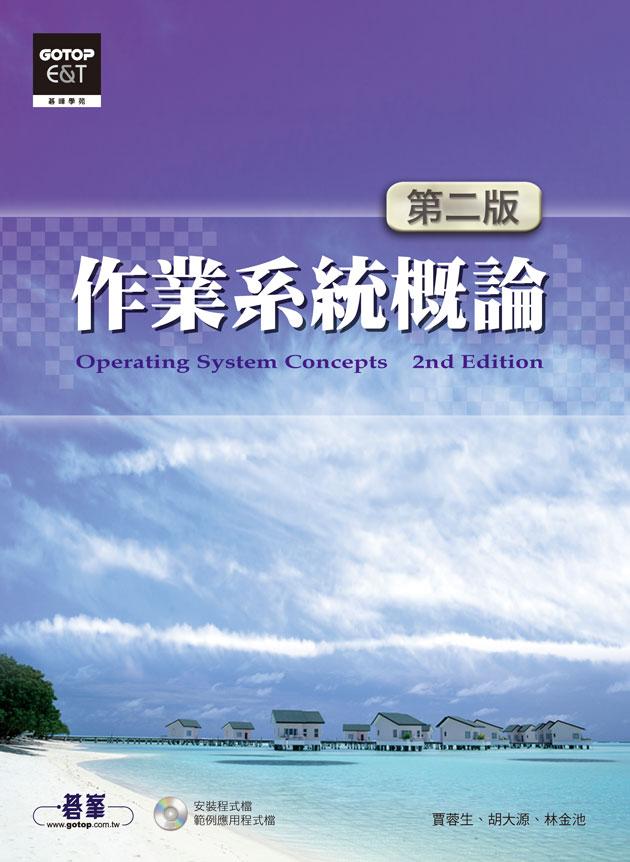內容簡介
內容簡介 作業系統(Operating System)是學習電腦的基礎課目,內容涵蓋電腦系統結構、執行管理、儲存管理、資料傳遞、網路應用、與保護安全等項目。在未來學習的大道上,這些項目提供了一個輪廓,可令讀者胸有成竹地向前邁進。為了讓本書能提供讀者多項有意義的協助,於編寫時,特別挹注閱讀特色如下:以精簡文辭與易懂附圖,中肯描述各章節內容,並伺機佐以離散數學之定律,使內容更深切清晰邏輯。於各章節理論概念之外,另輔以Java系統程式,此部份可供學校老師作為教學參考,有實作興趣的學習者亦可藉實作程式之設計,印證各項理論概念,使學習更為紮實有趣。編輯中英索引各約1,000個,幾已涵蓋所有中英專用名詞,儲備學習者閱讀原文書籍或期刊的能力。每章精選習作習題,協助讀者參加升學、公職、或求職等考試。
產品目錄
產品目錄 第一章 導讀1-1 簡介1-2 本書主要內容1-3 Java 系統程式1-4 專有名詞索引1-5 習作習題1-6 光碟使用第一篇 概論(Over View)第二章 基礎概念(Introduction)2-1 簡介2-2 大型電腦系統(Mainframe Systems)2-3 微型電腦系統(MicroComputer Systems)2-4 多處理器系統(MultiProcessor System)2-5 分散式系統(Distributed System)2-6 習題(Exercises)第三章 電腦系統結構(Computer System Structure)3-1 簡介3-2 起始操作(Start Running)3-3 中斷(Interrupt)3-4 輸入輸出架構(I/O Structure)3-5 儲存架構(Storage Structure)3-6 硬體保護(Hardware Protection)3-6-1 輸入輸出保護(I/O Protection)3-6-2 記憶體保護(Memory Protection)3-6-3 中央處理器保護(CPU Protection)3-7 網路架構(Network Structure)3-7-1 區域網域(Local-Area Network)3-7-2 廣域網域(Wide-Area Network)3-8 習題(Exercises)3-9 範例系統程式(Programming)3-9-1 中斷例外處理(模擬3-3節)第四章 作業系統架構(Operating System Structure)4-1 簡介4-2 系統組成要件(System Components)4-2-1 行程管理(Process Management)4-2-2 主記憶體管理(Main Memory Management)4-2-3 檔案管理(File Management)4-2-4 輸入輸出系統管理(I/O System Management)4-2-5 輔助記憶體管理(Secondary Storage Management)4-2-6 網路連通管理(Networking Management)4-2-7 保護系統管理(Protection Management)4-2-8 介面指令管理(Shell Command Interpreter Management)4-3 作業系統服務(Operating System Services)4-4 系統呼叫(System Calls)4-5 系統程式(System Programs)4-6 應用程式(Application Programs)4-7 系統架構(System Structure)4-7-1 簡易架構(Simple Structure)4-7-2 階層架構(Layered Approach)4-7-3 微核心(Microkernel)4-7-4 模組架構(Modules)4-8 虛擬機器(Virtual Machines)4-9 系統設計與編寫(System Design and Implementation)4-10 檢選系統(System Generation)4-11 開機系統(System Boot)4-12 習題(Exercises)第二篇行程管理(Process Management)第五章 行程(Processes)5-1 簡介5-2 行程之觀念(Process Concept)5-2-1 行程狀態(Process State)5-2-2 行程控制區段(Process Control Block)5-2-3 執行緒(Threads)5-3 排程(Process Scheduling)5-3-1 排程佇列(Scheduling Queues)5-3-2 排程器(Schedulers)5-3-3 內文切換(Context Switch)5-4 行程操作(Operations on Processes)5-4-1 行程產生 (Process Creation)5-4-2行程結束(Process Termination)5-5 合作行程 (Cooperating Processes)5-6 行程通訊 (Interprocess Communication)5-6-1 訊息傳遞(Message Passing System)5-6-2 同步操作(Synchronization)5-6-3 緩衝(Buffering)5-7 網路連通(Server/Client Network)5-8 習題(Exercises)5-9 範例系統程式5-9-1 父行程與子行程之繼承關係(模擬5-4-1節)5-9-2 合作行程(模擬5-5節)5-9-3 網路連通(模擬5-7節)第六章 執行緒(Threads)6-1 簡介6-2 執行緒定義(Overview)6-3 多執行緒模型(Multithreading Models)6-4 執行緒操作(Operations of Threads)6-4-1 執行緒之終止(Cancellation)6-4-2 信號管理(Signal Handling)6-4-3 執行緒池(Thread Pools)6-5 執行緒與CPU(Threads and CPU)6-6 習題(Exercises)6-7 範例系統程式(Programming)6-7-1 執行緒與CPU(模擬6-5節)第七章 CPU排程(Scheduling)7-1 簡介7-2 排程概念(Scheduling Concepts)7-2-1 CPU與I/O週期(CPU and I/O Cycle)7-2-2 CPU排程器(Scheduler)7-2-3 搶先排程(Concept of Preemptive Scheduling) 概念7-2-4 分配器(Dispatcher)7-3 排程評量要件(Scheduling Criteria)7-4 排程演算法(Scheduling Algorithms)7-4-1 先到先執行(FCFS First-Come-First-Served Scheduling)7-4-2 最短工作優先(SJF Shortest-Job-First Scheduling)7-4-3 搶先排程( Preemptive Scheduling)7-4-4 優先權排程( Priority Scheduling)7-4-5 循環分時 (RR Round-Robin) 排程7-4-6 多層佇列(Multilevel Queues) 排程7-4-7 多層回授佇列 (Multilevel Feedback-Queue) 排程7-4-8 多處理器 (Multi-Processor) 排程7-5 排程評量(Algorithm Evaluation)7-6 習題(Exercises)7-7 範例系統程式(Programming)7-7-1 優先權排程(模擬7-4-4節)第八章 行程與同步並行(Process Synchronization)8-1 簡介8-2 並行條件(Concurrency Conditions)8-3 臨界區(Critical Section)8-4 兩任務演算法(Two-Tasks Algorithms)8-4-1 演算法1(Algorithm1)8-4-2 演算法2(Algorithm2)8-4-3 演算法3(Algorithm3)8-5 硬體並行指令(Synchronization Hardware)8-5-1 方法程序getAndset8-5-2 方法程序swap8-6 信號(Semaphores)8-6-1 信號(Semaphores) 與臨界區(Critical Section)8-6-2 信號(Semaphores) 與並行序列(Synchronization)8-7 應用(Application)8-8 習題(Exercises)8-9 範例系統程式(Programming)8-9-1 臨界區演算法1(模擬8-4-1節)8-9-2 臨界區演算法2(模擬8-4-2節)8-9-3 臨界區演算法3(模擬8-4-3節)8-9-4 臨界區硬體指令getAndset(模擬8-5-1節)8-9-5 臨界區硬體指令getAndset(模擬8-5-2節)8-9-6 號碼機與synchronized類別(模擬8-7節)第九章 死結(Deadlocks)9-1 簡介9-2 死結定義(Deadlock Definition)9-3 死結特性(Deadlock Characterization)9-3-1 必要條件(Necessary Conditions)9-3-2 資源分配圖(Resource-Allocation Graph)9-4 死結預防(Deadlock Prevention)9-5 死結避免(Deadlock Avoidance)9-5-1 銀行家概念(Conception of Banker)9-5-2 安全演算法(Safety Algorithm)9-5-3 資源要求演算法(Resource Request Algorithm)9-5-4 單一裝置(Single Instance)9-6 死結偵測(Deadlock Detection)9-6-1 偵測演算法9-6-2 單一裝置(Single Instance)9-6-3 啟動偵測時機(Detection Algorithm Usage)9-7 死結消弭(Recovery from Deadlock)9-7-1 行程終止法(Process Termination)9-7-2 資源釋放法(Resource Preemption)9-8 習題(Exercises)9-9 範例系統程式(Programming)9-9-1 循環等待之死結(模擬9-3-2節)第三篇 儲存管理(Storage Management)第十章 記憶體管理(Memory Management)10-1 簡介10-2 記憶體之觀念(Concept of Memory)10-2-1 地址方式(Address Binding)10-2-2 邏輯地址/實體地址(Logical / Physical Address)10-2-3 機動載入/連接(Dynamic Loading / Linking)10-2-4 重疊(Overlays)10-3 置換(Swapping)10-3-1 回存裝置(Backing Store)10-3-2 置換時間10-3-3 重疊置換(Overlapped Swapping)10-4 連續記憶體配置(Contiguous Memory Allocation)10-4-1 記憶體保護(Memory Protection)10-4-2 記憶體分配(Memory Allocation)10-4-3 碎片(Fragmentation)10-5 分頁(Paging)10-5-1 分頁方法(Paging Methods)10-5-2 硬體支援(Hardware Support)10-5-3 框頁保護(Frames Protection)10-5-4 框頁分享(Shared Pages)10-6 區段(Segmentation)10-7 區段分頁(Segmentation with Paging)10-8 習題(Exercises)10-9 範例系統程式(Programming)10-9-1 區段應用(模擬10-6節)第十一章 虛擬記憶體(Virtual Memory)11-1 簡介11-2 虛擬記憶體之觀念(Concept of Virtual Memory)11-3 分頁要求(Demand Paging)11-3-1 分頁要求觀念(Concept of Demand Paging)11-3-2 分頁要求之執行意義(Performance of Demand Paging)11-4 框頁替換(Page Replacement)11-4-1 框頁替換之觀念(Concept of Page Replacement)11-4-2 先入先出框頁替換(FIFO Page Replacement)11-4-3 最佳框頁替換(Optimal Page Replacement)11-4-4 最近最少使用框頁替換(Least Recently Used Page Replacement)11-4-5 近似LRU演算法(LRU Approximation Page Replacement)11-4-5-1 增額參考位元演算法(Additional Reference Bits Algorithm)11-4-5-2 二次機會演算法(Second-Chance Algorithm)11-4-5-3 進階二次機會演算法(Enhance-Second-Chance Algorithm)11-4-6 計次框頁替換(Counting-Based Page Replacement)11-4-7 框頁緩衝器演算法(Page Buffering Algorithm)11-4-8 框頁替換之應用(Applications and Page Replacement)11-5 頁框分配(Allocation of Frames)11-5-1 最少頁框數量需求(Minimum Number of Frames)11-5-2 頁框分配演算法(Allocation Algorithms)11-5-3 全域/局部分配(Global/Local Allocation)11-6 輾轉混亂現象(Thrashing)11-6-1 輾轉混亂現象之肇因(Cause of Thrashing)11-6-2局部框頁替換(Local Replacement)11-6-3工作組模型(Working Set Model)11-6-4 選頁錯誤頻率(Page Fault Frequency)11-7 其他考量(Other Considerations)11-8 習題(Exercises)11-9 範例系統程式(Programming)11-9-1 分頁設計(模擬11-3-2節)第十二章 檔案系統介面(File System Interface)12-1 簡介12-2 檔案概念(File Concept)12-2-1 檔案屬性特徵(File Attributes)12-2-2 檔案操作(File Operations)12-2-3 開啟 / 關閉檔案(Open / Close File)12-2-4 鎖住 / 釋出檔案(Lock / Release File)12-2-5 檔案類型(File Types)12-3 檔案存取方法(Access Methods)12-4 目錄結構(Directory Structure)12-4-1 單層目錄(Single Level Directory)12-4-2 雙層目錄(Two Level Directory)12-4-3 樹狀目錄(Tree Structured Directories)12-4-4 非迴路圖形目錄(Acyclic Graph Directories)12-4-5 綜合圖形目錄(General Graph Directories)12-5 檔案系統掛載(File System Mounting)12-6 檔案分享(File Sharing)12-7 檔案保護(File Protection)12-8 習題(Exercises)12-9 範例系統程式(Programming)12-9-1 讀取檔案屬性(模擬12-2-1節)12-9-2 檔案之寫入/讀取(模擬12-2-2節)第十三章 檔案系統運作(File System Implementation)13-1 簡介13-2 檔案系統結構(File System Structure)13-3 檔案系統運作(File System Implementation)13-3-1 檔案系統概念(Concept of File System)13-3-2 分割區與掛載(Partitions and Mounting)13-3-3 虛擬檔案系統(Virtual File System)13-4 目錄運作(Directory Implementation)13-5 空間分配方法(Allocation Methods)13-5-1 連續空間分配(Contiguous Allocation)13-5-2 鏈接空間分配(Linked Allocation)13-5-3 索引空間分配(Indexed Allocation)13-5-4 運作性能(Performance)13-6 空白空間之管理(Free Space Management)13-7 網路檔案系統(NFS Network File System)13-8 習題(Exercises)第四篇 輸入輸出(Input and Output)第十四章 輸入輸出系統(I/O Systems)14-1 簡介14-2 概念(Overview)14-3 I/O硬體(I/O Hardware)14-3-1 匯流排(Bus)14-3-2 連接埠(Port)14-3-4 中斷(Interrupts)14-3-5 直接記憶體存取(Direct Memory Access)14-4 I/O介面應用(Application I/O Interface)14-5 核心I/O次系統(Kernel I/O Subsystem)14-6 硬體I/O操作(Transforming I/O to Hardware Operation)14-7 串流(Streams)14-8 執行效率(Performance)14-9 習題(Exercises)14-10 範例系統程式(Programming)14-10-1 資料串流FileInputStream與FileOutStream(模擬14-7節)14-10-2 資料串流DataInputStream與DataOutStream(模擬14-7節)第十五章 大量儲存結構(Mass Storage Structure)15-1 簡介15-2 磁碟結構(Disk Structure)15-3 磁碟排程(Disk Scheduling)15-3-1 先到先執行(FCFS Scheduling)15-3-2 最短搜尋時間先執行(SSTF Scheduling)15-3-3 掃瞄排程(Scan Scheduling)15-3-4 C-掃瞄排程(C-Scan Scheduling)15-3-5 掃瞄判斷排程(Look Scheduling)與C-掃瞄判斷排程(C-Look Scheduling)15-3-6 磁碟排程分析(Disk Scheduling Selection)15-4 磁碟管理(Disk Management)15-4-1 磁碟格式化(Disk Formatting)15-4-2 起動區塊(Boot Blocks)15-4-3 損壞區塊(Bad Blocks)15-5 置換空間管理(Swap Space Management)15-6 磁碟矩陣結構15-6-1 安全可信度(Reliability)15-6-2 並行方式(Parallelism)15-6-3 磁碟矩陣階層(RAID Level)16-6-4 磁碟矩陣階層分析(Selecting a RAID Level)15-7 磁碟掛載應用(Disk Attachment)15-7-1 本機掛載儲存裝置(Host Attached Storage)15-7-2 網路掛載儲存裝置(Network Attacked Storage)15-7-3 儲區網路(Storage Area Network)15-8 穩定儲存應用(Stable Storage Implementation)15-9 習題(Exercises)第五篇 分散式系統(Distributed System)第十六章 分散式系統結構(Distributed System Structures)16-1 簡介16-2 概念(Background)16-2-1 分散式系統之優點(Advantages of Distributed Systems)16-2-2 分散式作業系統之類型(Types of Distributed Operating System)16-3 節點連接(Topology)16-4 網路通訊(Communication)16-4-1 名稱解析(Naming Resolution)16-4-2 路由策略(Routing Strategies)16-4-3 連接策略(Connection Strategies)16-4-4 衝突避免(Contention)16-5 網路通訊協定(Communication Protocols)16-6 網路故障處理(Robustness)16-7 習題(Exercises)16-8 範例系統程式(Programming)16-8-1 網路節點連接(模擬16-3節)16-8-2 網路節點連接(模擬16-4-1節)16-8-3 網路線路/資料交換(模擬16-4-3節)第十七章 分散式檔案系統(Distributed File System)17-1 簡介17-2 概念(Background)17-3 名稱與通透性(Naming and Transparency)17-3-1 名稱結構(Naming Structure)17-3-2 名稱方案(Naming Schemes)17-4 遠端檔案存取(Remote File Access)17-4-1 快取方案(Caching Scheme)17-4-2 快取位置(Cache Location) 17-4-3 更新快取資料(Cache Update) 17-4-4 一致性(Consistency) 17-4-5 快取與遠端服務之比較(Comparison of Caching and Remote Service) 17-5 檔案複製(File Replication)17-6 習題(Exercises)17-7 範例系統程式17-7-1 遠端檔案儲存(模擬17-4節)17-7-2 遠端檔案複製(模擬17-5節)第十八章 分散式系統之整合(Distributed Coordination)18-1 簡介18-2 事件序列(Event Ordering)18-2-1 先後關係式(Happened Before Relation)18-2-2 應用(Implementation)18-3 互斥(Mutual Exclusion)18-3-1 集中式執行(Centralized Approach)18-3-2 分散式執行(Distributed Approach)18-3-3 令牌傳遞執行(Token Passing Approach)18-4 緊密聚合(Atomicity)18-4-1 兩階段協定(Two Phase Commit Protocol)18-4-2 故障處理(Failure Handling in 2PC)18-4-2-1 地區站台(Site) 故障18-4-2-2 協調機制(Coordinator) 故障18-4-2-3 網路連線(Network) 故障18-5 死結處理(Deadlock Handling)18-5-1 死結的預防與避免(Deadlock Prevention and Avoidance)18-5-2 死結的偵測(Deadlock Detection)18-5-2-1 集中式執行(Centralized Approach)18-5-2-2 分散式執行(Distributed Approach)18-5-3 死結的消弭(Recovery From Deadlock)18-6 習題(Exercises)18-7 範例程式18-7-1 網路集中/協調(模擬18-3-1節)第六篇 保護與安全(Protection and Security)第十九章 保護(Protection)19-1 簡介19-2 保護的目的(Goal of Protection)19-3 保護之定義域 (Protection Domain)19-3-1 定義域結構(Domain Structure)19-3-2 定義域代表(Domain Representations)19-4 矩陣執行(Access Matrix)19-4-1 複製功能(Copy)19-4-2 擁有者功能(Owner)19-4-3 控制功能(Control)19-5 矩陣應用(Implementation Matrix)19-5-1 全域表格(Global Table)19-5-2 物件權限串列(Access Lists for Objects)19-5-3 定義域能力串列(Capability Lists for Objects)19-6 習題(Exercises)19-7 範例系統程式(Programming)19-7-1 矩陣應用(模擬19-5節)第二十章 安全(Security)20-1 簡介20-2 安全問題(Security Problem)20-3 使用者確認(User Authentication)20-4 程式安全之威脅(Program Threats)20-5 系統安全之威脅(System Threats)20-6 加解密(Cryptography)20-6-1 傳統加密法20-6-2 近代公開金匙加密法20-6-2-1 公開金匙原理20-6-2-2 金匙設計方法20-6-2-3 金匙設計執行法則20-6-2-4 金匙設計實例(Java 範例程式設計)20-7 習題(Exercises)20-8 範例系統程式(Programming)20-8-1 傳統加解密法(模擬20-6-1節)20-8-2 近代加解密法(模擬20-6-2節)第七篇 應用系統(Application System)第二十一章 Windows XP 系統21-1 簡介21-2 Windows 作業系統沿革21-3 設計觀點21-4 系統單元21-5 環境次系統21-6 檔案系統21-7 網路系統21-8 程式設計者之介面第二十二章 Windows Vista 系統22-1 簡介22-2 Windows Vista與 Windows XP22-3 Vista/XP部份功能22-4 Vista與Office 200722-5 Vista版本22-6 一般使用22-6-1 導覽流暢22-6-2 Windows Vista Aero22-6-3 搜尋與組織功能22-6-4 資訊看板與小工具22-6-5 瀏覽器(Explorer 7)22-6-6 安全保護22-6-7 效能22-6-8 網路應用22-7 家庭使用22-7-1 輕鬆傳輸22-7-2 家長監護設定22-7-3 相片圖庫22-7-4 多媒體中心22-7-5 其他功能22-8 商業使用22-8-1 XPS文件22-8-2 協同作業22-8-3 其他功能22-9 專業使用22-9-1 部署22-9-2 進階網路22-9-3 系統需求22-9-4 其他功能第二十三章 Linux 系統23-1 簡介23-2 Linux作業系統沿革23-3 設計觀點23-4 核心模組23-5 行程管理23-6 排程23-7 記憶體管理23-8 檔案管理23-9 網路架構23-10 安全保護第二十四章 Java 系統24-1 簡介24-2 使用者程式區塊(User's Program Component)24-2 應用程式介面(API Application Program Interfaces)24-3 Java虛擬器(Virtual Machine)24-4 Java執行環境(Java Development Environment)附錄A 第一個Java程式附錄B Java例外處理內建類別附錄C Java I/O方法程序附錄D 中英文名詞索引附錄E 英文名詞索引附錄F 參考資料
